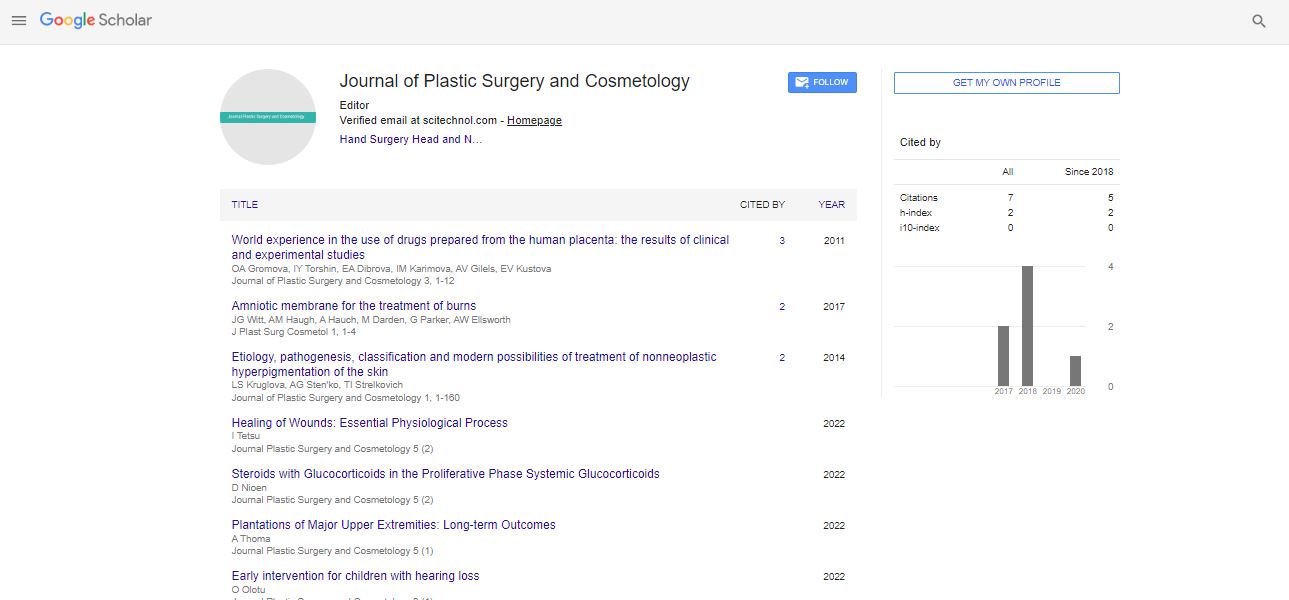Perspective, J Pls Sur Cos Vol: 12 Issue: 2
Revitalization of Face: Techniques, Considerations, and Outcomes in Facial Rejuvenation Surgery
Huseyin Dave*
Diepenbrock Facial Cosmetic Surgery/Oral and Maxillofacial Surgery Associates, Carnegie Boulevard, Fort Wayne, USA
*Corresponding Author: Huseyin Dave,
Diepenbrock Facial Cosmetic Surgery/Oral and Maxillofacial Surgery Associates, Carnegie Boulevard, Fort Wayne, USA;
E-mail: Daveseyin11@hotmail.com
Received date: 29 May, 2023, Manuscript No. JPSC-23-106794;
Editor assigned date: 31 May, 2023, PreQC No. JPSC-23-106794(PQ);
Reviewed date: 14 June, 2023, QCNo JPSC-23-106794;
Revised date: 21 June, 2023, Manuscript No. JPSC-23-106794(R);
Published date: 30 June, 2023, DOI: 10.4172/JPSC.100053
Citation: Dave H (2023) Revitalization of Face: Techniques, Considerations, and Outcomes in Facial Rejuvenation Surgery. J Pls Sur Cos 12:2.
Description
Facial rejuvenation surgery encompasses a range of procedures aimed at restoring a youthful appearance to the face. This study provides an overview of facial rejuvenation surgery techniques, patient considerations, and outcomes. It discusses facelifts, brow lifts, blepharoplasty, and neck lifts, highlighting the surgical approaches involved, potential complications, and expected outcomes. Additionally, it explores the importance of patient selection, realistic expectations, and the integration of non-surgical facial rejuvenation techniques. Understanding the various facial rejuvenation surgery procedures and their outcomes is important for patients considering these interventions and for surgeons involved in their care.
Facial rejuvenation surgery has become increasingly popular as individuals seek to restore a youthful appearance and address the signs of facial aging.
Facial rejuvenation surgery, as encapsulated in the title "Revitalizing the Face," offers individuals the opportunity to restore a youthful appearance and address the visible signs of aging. This note delves into the techniques, considerations, and outcomes involved in facial rejuvenation surgery.
Factors
With the passage of time, factors such as sun exposure, gravity, and the natural aging process can contribute to facial sagging, wrinkles, and loss of skin elasticity. Facial rejuvenation surgery encompasses a range of procedures, including facelifts, brow lifts, blepharoplasty (eyelid surgery), and neck lifts, to counteract these effects and revitalize the face.
Considerations in facial rejuvenation surgery include patient selection, realistic expectations, and comprehensive preoperative counseling. Each patient's unique facial anatomy and aesthetic goals are taken into account to develop an individualized treatment plan. Thorough education and communication ensure that patients understand the anticipated outcomes, potential risks, and recovery process.
Significance
Outcomes in facial rejuvenation surgery can be transformative. Patients often report heightened self-confidence, improved self-image, and a more youthful appearance. By addressing the visible signs of aging, these procedures have the potential to positively impact both physical and emotional well-being.
Facelifts, or rhytidectomies, are surgical procedures aimed at improving visible signs of facial aging, such as sagging skin and deep wrinkles. Brow lifts address the forehead and brow area, elevating drooping eyebrows and reducing forehead wrinkles. Blepharoplasty, or eyelid surgery, rejuvenates the appearance of the eyes by removing excess skin, fat, and muscle from the upper and/or lower eyelids. Neck lifts target sagging skin and muscle bands in the neck area, resulting in a more defined and youthful neck contour. Each procedure has specific surgical techniques and associated risks, including infection, bleeding, scarring, and temporary or permanent nerve injury.
Patient selection and realistic expectations play vital roles in achieving successful outcomes and high patient satisfaction rates in facial rejuvenation surgery. Thorough preoperative counseling is important in educating patients about the anticipated outcomes, potential risks, and recovery process. Additionally, non-surgical facial rejuvenation techniques, such as injectables and laser treatments, can be integrated into treatment plans to optimize results and delay the need for surgery. Combining surgical and non-surgical approaches allows for individualized treatment plans based on the patient's unique needs and desired outcomes.
Conclusion
Facial rejuvenation surgery offers individuals the opportunity to address visible signs of facial aging and restore a more youthful appearance. Understanding the various surgical techniques, patient considerations, and associated risks is important for both patients considering these procedures and surgeons involved in their care. Patient selection, realistic expectations, and a comprehensive approach that incorporates non-surgical facial rejuvenation techniques contribute to achieving successful outcomes and high patient satisfaction rates in facial rejuvenation surgery.
 Spanish
Spanish  Chinese
Chinese  Russian
Russian  German
German  French
French  Japanese
Japanese  Portuguese
Portuguese  Hindi
Hindi 